Глазури причерноморских средневековых посудных майолик: химический состав по данным спектрального анализа
Glazes of Black Sea Region Medieval Tableware Majolica: chemical composition according to spectral analysis
Author(s): Vladimir Yu. Koval
Subject(s): History, Archaeology, Middle Ages, 13th to 14th Centuries, 15th Century
Published by: Издательский дом Stratum, Университет «Высшая антропологическая школа»
Keywords: Black Sea region; Middle Ages; majolica; glaze; chemical composition; X-ray analysis
Summary/Abstract: Investigatios of 52 glazes samples (40 of them are examples of Byzantine-Black Sea origin) by X-ray microprobe technique allowed to make conclusions about the difference of the Byzantine (and its successor on North Black Sea Coast and the Golden Horde traditions) composition from the West-Mediterranean (Spanish-Italian), in particular for the 15th century. One of the results of these investigations is the discovery of the downward trend rate of lead oxide in the Byzantine and Black Sea glazes during the 12th—15th centuries, refuting earlier formulated hypotheses about the growth of the share of lead materials in “Chersonesus” glaze recipe. The author also notes the lack of reliable data on glazed pottery production in medieval Cherson.
Book: Поливная керамика Средиземноморья и Причерноморья X—XVIII вв.
- Page Range: 725-738
- Page Count: 14
- Publication Year: 2017
- Language: Russian
- Content File-PDF

